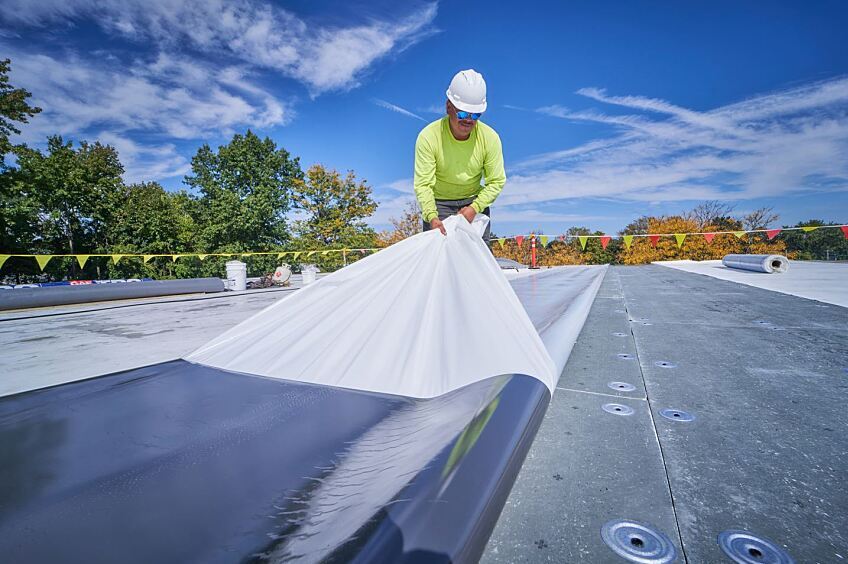La main d’œuvre étant limitée, trouver des produits qui font gagner du temps figure en haut de la liste de choses à faire de nombreux entrepreneurs. Gagner du temps ne veut pas dire compromettre la qualité. En effet, les entrepreneurs travaillent sans cesse pour offrir des solutions qui aident à améliorer l’efficacité d’une installation qui continue d’être de première classe.
To help contractors save time while still producing high-quality work, GAF offers several products that can help a commercial roofing business do more in less time.
1. How Long Does Spray Adhesive Take to Dry?
EverGuard® TPO Quick Spray Adhesive has a flash time of five minutes or less and can be applied 50 % faster than traditional bucket and roller adhesive. Lorsqu’il est utilisé correctement, un seul bidon peut couvrir l’installation d’environ 10 carrés, alors qu’un seau peut couvrir environ trois carrés. (As with all adhesives, the substrate's porosity can impact coverage rates.)
Because it's a solvent-based adhesive, it's sprayable, allowing installers to quickly bond thermoplastic polyolefin (TPO) membrane to a variety of approved substrates. Il suffit de le pulvériser uniformément sur le substrat et à l’arrière de la membrane. Then, apply pressure with a broom or weighted roller to ensure adhesion and heat-weld the seams.
2. How Do TPO Accessories Save Time?
It can take a significant amount of time, experience, and know-how to properly measure, cut, and hand-weld details. GAF TPO accessories are available for most details of a rooftop, offering a full line of vent and pipe boots, tube wraps, pourable sealer pockets, and universal corners that can be cut to accommodate either an inside or outside corner.
When the accessory is ready to install with no field fabrication, you'll find that installers not only save time but also achieve consistent quality in all the flashings while boosting their productivity.
3. How Does Fabricated Edge Metal Save Time?
Fabricating edge metal in the field requires time and experience, not to mention the additional equipment needed to form the metal. GAF Perimeter Edge Metal saves hours of time in the field, and the coping, drip edges, fascia, and accessories are easy to install with features like prepunched holes to ensure the secure termination of the membrane.
Because all GAF edge metal is tested and compliant with the ANSI/SPRI ES-1, FM, Miami Dade, and Florida Building Code for IBC, you can have confidence in knowing that the most critical point on the roof—the perimeter—has the highest protection.
4. What Is a Self-Adhered Roofing System?
A self-adhered roofing system is up to 60 % faster to install than a roof that is traditionally adhered. Le TPO autoadhésif élimine complètement la nécessité d’appliquer un adhésif. EverGuard® SA TPO Self-Adhered Roof Membrane comes with the adhesive already applied on the back of the membrane. Une fois en place, l’équipe n’a plus qu’à replier la feuille de membrane, à retirer la pellicule de protection pour exposer l’adhésif appliqué en usine, à poser la membrane en place et à balayer la feuille. The crew then uses a weighted roller and heat-welds the seams.
You not only save time during the installation, but you also save time cleaning up the jobsite as there are no buckets, rollers, or containers to dispose of.
5. How Does a Self-Adhered Vapor Barrier Work?
GAF SA Vapor Retarder XL relies on an advanced, high-tack butyl rubber adhesive and is self-sealing, resulting in three times the peel strength of modified bitumen self-adhered vapor barriers.
It also saves time right off the bat by eliminating the need for primer prior to installation. Les grands rouleaux à six carrés réduisent le nombre de rouleaux nécessaires par travail, ce qui permet de réduire le nombre de joints. Its extreme durability allows it to be left exposed to the elements for up to six months when properly installed, plus it provides a slip-resistant walking surface for added safety.
6. Can Using PVC Save Time?
Time studies have proven that EverGuard® PVC can be installed up to 50 % faster than traditional adhered systems when using EverGuard® PVC Quick-Lay Adhesive. Le PVC est extrêmement polyvalent en ce qui concerne les méthodes d’installation, puisqu’il peut être collé, fixé mécaniquement ou soudé par induction. Available PVC accessories and adhesives also speed up the installation.
7. How Can Wider Membrane Rolls Save Time?
When self-adhered TPO isn't an option, roofers can make their installation time more efficient by using rolls of membrane that are wider than the standard 10 feet, known as extra-wide roll roofing. GAF offers 12-foot-wide rolls of membrane that are ideal for jobs with large, open rooftop areas. As well as providing more coverage in less time, these 20 %-wider rolls mean fewer seams to weld.
Learn from the Highly Trained Professionals at GAF
GAF offers a robust video library featuring roofing veterans Dave Scott and Wally Brown. Their Roofing It Right series features how-to videos, including a self-adhered membrane product overview. These videos cover topics as diverse as roof inspections, core cuts, tear-offs, and installations.
The GAF Commercial team offers step-by-step support with highly trained, regionally based professionals who can understand your unique challenges in tapered design, product installation, energy efficiency, sustainability, and more. Find your local team and save time.

